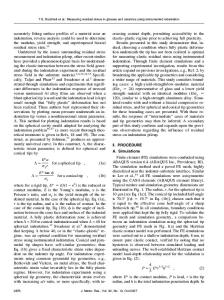Augmented instrumented indentation using nonlinear electrical contact current-voltage curves
- PDF / 1,579,207 Bytes
- 13 Pages / 584.957 x 782.986 pts Page_size
- 61 Downloads / 428 Views
Christopher L. Muhlstein, Amber L. Romasco, and James G. Collins Department of Materials Science and Engineering, The Pennsylvania State University, University Park, Pennsylvania 16802
Lawrence H. Friedmana) Department of Engineering Science and Mechanics, The Pennsylvania State University, University Park, Pennsylvania 16802 (Received 12 September 2008; accepted 28 January 2009)
An electrical technique was recently developed to measure the in situ contact area continuously during instrumented indentation by simultaneously monitoring electrical contact response between a conductive indenter tip and a conductive sample. This technique has the potential to overcome limitations of the Oliver-Pharr method caused by the lack of a direct contact area measurement. However, the electrical contact currentvoltage (I-V) curves measured from the technique were nonlinear, posing a significant challenge to inferring accurate in situ contact areas. To overcome this challenge and extend the electrical technique to more applications, various I-V curve analysis methods were investigated for their abilities to infer in situ contact area and hardness. Annealed Cu was indented using both linear and exponential loading tests. When analyzing the resulting data, the feasibility of each method was evaluated and the optimal methods to calculate the in situ contact area and hardness were determined. It was found that a simple summation of the absolute values of area under I-V curves or the area under I-V curves at positive voltages yielded the most robust area measure, whereas error in the inferred contact area was systematic and primarily from velocity dependence of the I-V response.
I. INTRODUCTION
Instrumented indentation along with the Oliver-Pharr data analysis method have been widely used for mechanical characterization of materials, especially at small length scales.1–4 However, the lack of direct contact area measurement from the Oliver-Pharr method5,6 is a fundamental limitation that confounds instrumented indentation when characterizing dynamic properties of materials (e.g., creep and fatigue), materials exhibiting pileup,7,8 and thin films.9–11 More recently, an electrical technique was demonstrated to measure the in situ contact area continuously during instrumented indentation of a bulk metal that does not pileup by simultaneously monitoring electrical contact current-voltage (I-V) response between a conductive indenter tip and a more conducting sample (Fig. 1).12 This technique used the Oliver-Pharr method for calibration; however, it gave contact area and hardness during loading and holding as a continuous function of a)
Address all correspondence to this author. e-mail: [email protected] DOI: 10.1557/JMR.2009.0213
1820
http://journals.cambridge.org
J. Mater. Res., Vol. 24, No. 5, May 2009 Downloaded: 19 Mar 2015
the applied force instead of a single value for the OliverPharr method from unloading. This electrical technique not only enhanced the Oliver-Pharr method but also laid the foundation for a stand-alone m
Data Loading...











